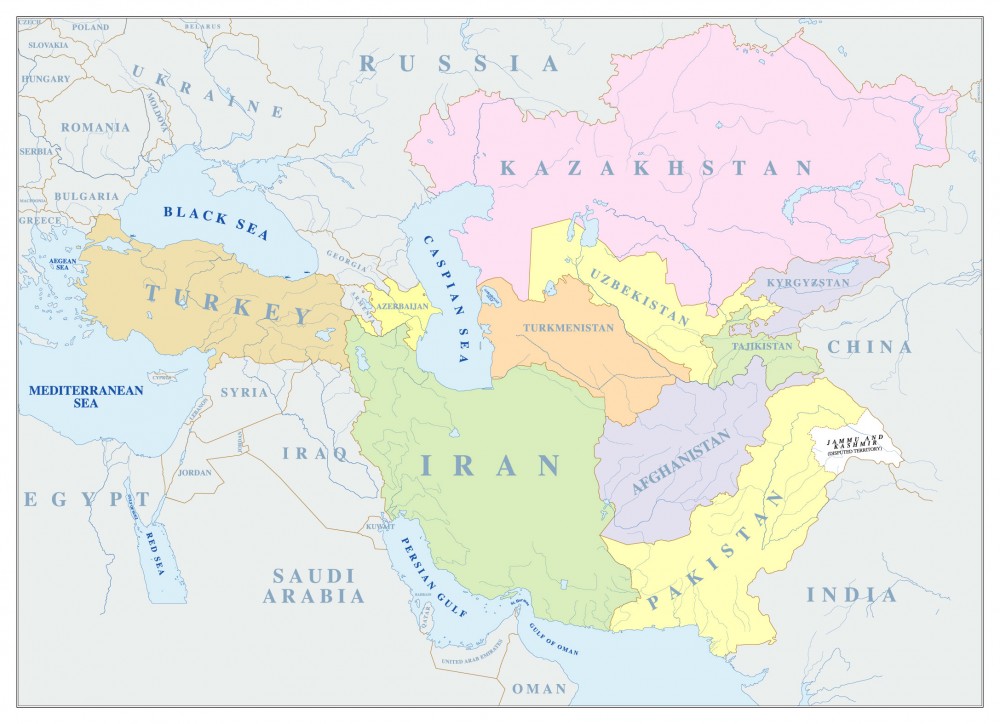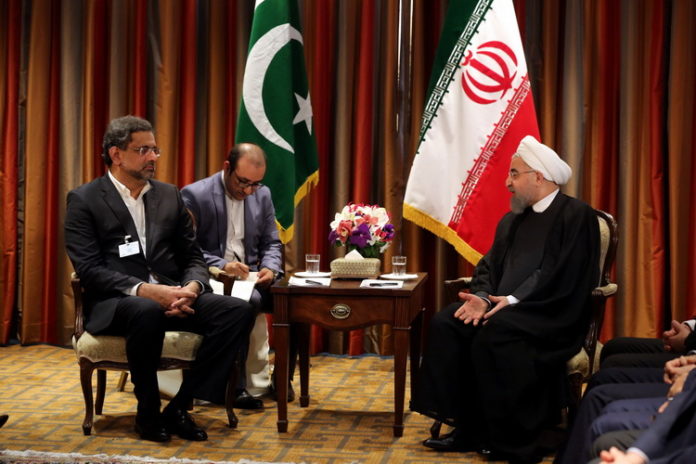The geographic and economic importance of Iran is a key factor that must be considered thoroughly in our defence doctrine. Iran is the southwestern neighbor of Pakistan and an Islamic country that has deep cultural, historic and religious roots with Pakistan. This is a large country, about 1.5 times the size of Pakistan with a population of 83 million. Iran is an oil rich country having borders with Iraq, Turkey, Afghanistan, Pakistan, some of the central Asian states, Caspian Sea and Persian Gulf. Strategically, Iran has the long coastal line in Persian Gulf hence it is closer to all Arabian Gulf states and a considerable part of maritime domain exits in the Gulf of Oman and Arabian Sea.
On the other hand, Pakistan’s total border length with all its neighbors is approximately 6774 km. The border with traditional rival India is 3652 km long in the east including areas of Line of Control which has heavy military presence, 2252 km long border with Afghanistan through the Durand Line which Afghanistan does not recognize, 585 km border with traditional ally China and 909 km long border with Iran. The relations between Pakistan and Iran were pleasant during the Shah’s time but have definitely undergone some ups and downs after that period.
After the independence of Pakistan on 14th August 1947, Iran had the unique distinction of being the first country to internationally recognize the sovereign status of Pakistan, thereafter the two-continued cooperating with each other economically. This cooperation lasted throughout the Cold War with Iran supporting Pakistan in its conflicts with arch-rival, India and in return, Pakistan supporting Iran militarily during the Iran–Iraq War in the 1980s. Since 2000, relations between the two states relatively normalized and economical and military collaboration strengthened the relationship. Both countries are founding members of the Economic Cooperation Organization (ECO) and RCD, the Regional Cooperation for Development.

Pakistan’s relations with Iran have been strained at times due to sectarian tensions but nevertheless, economic and trade relations continued to expand in both absolute and relative terms, leading to the signing of a Free Trade Agreement between the two countries in 1999. At present, both countries are cooperating and forming alliances in a number of areas of mutual interest, such as fighting the drug trade along their common border and combating the Baluchistan insurgency along their border. Iran has also expressed an interest in joining the China-Pakistan Economic Corridor (CPEC). The Iranian role became critical after the 1979 Islamic revolution. The western world had good economic and military relations with Iran at the time of the Shah and provided her with every help to strengthen the Shah’s regime. The Islamic revolution in Iran and the Shah’s exile was a setback for the United States, Europe and especially Israel who managed to get superior strategic status in the Middle east after capturing Arab lands and Golan Heights as the result of the first Arab-Israeli war. Iran’s role also became critical after the US invasion of Iraq in 2003. Iran with its future nuclear capability may become a challenge for the allied forces and Israel.
Iran has vast land consisting of hard terrain and mountainous regions and due to its physical and strategic importance, Iran will continue to be a key player in regional politics. It can be concluded, having seeing situation in Afghanistan that an economically stable and militarily strong Iran is important for the defence of Pakistan due to the reasoning of it being a next border neighbor. Pakistan cannot afford to have most of its borders either hostile or unstable.
Trade between Pakistan and Iran peaked at uS$1.32 billion in 2008-2009 but subsequently declined and is presently around just US $265 million. The elected governments in both countries want to boost trade which remained low due to international sanctions on Iran. However, several other countries like China, Russia and India were able to resist these sanctions and maintained trade relations with Iran, Pakistan should do the same and maintain trade relations with Iran. The trade volume between the two countries remained low despite signing of a Preferential Trade Agreement on March 4, 2004, which became operational in September 1, 2006. Nevertheless, it is understood that the two countries have a much higher trade volume through informal channels i.e. smuggling and through third country transactions. Pakistan has identified five places for setting up trading centers along the Pak-Iran border i.e.
– Taftan-Minjaveh
– Ladgashtjalaq
– Parome-Kuhak
– Mand-Peshin
– Santsar-Nobandan
The purpose of these common border markets is to sell goods at a concessional rate of customs duty and other taxes to control the growing cross border illegal trade. There are three main and critical areas given below where utmost attention must be paid for economic boost and mutual vision of prosperity between Pakistan and Iran. Comparatively lesser attention was focused on these areas due to UN sanctions but we must find a way out for promoting business and trade.
1- Iran Pakistan Gas Pipeline
2- Eurasian Connectivity thru RCD Extension
3- TIPEC (Turkey-Iran-Pakistan Economic Corridor)

Iran Pakistan Gas pipeline
The Iran Pakistan Gas Pipeline project or IP Gas Pipeline Project is under construction; this is a 2,775- kilometer pipeline to deliver natural gas from Iran to Pakistan and it must be completed at any cost. This is a key and critical project for establishing strategic relations and enhancing economic cooperation between the two countries. It would ensure the supply of 750 million cubic feet of natural gas per day to Pakistan which is required to keep its industrial and commercial wheels in perpetual motion. Even though Iran has to be dealt carefully due to sanctions, Pakistan has to manage one way or another for execution of this project.
It is expected that gas delivered from Iran through the pipeline will cost US$11 per million British thermal unit (MMBTu) compared to $13 per MMBTu which is expected to be price of gas delivered through the proposed Trans-Afghanistan Pipeline and $18 per MMBTu of imported LNG.
The pipeline’s section in Iran was built by the National Iranian Gas Company using Khatam al-Anbia as a subcontractor. In Pakistan, a consortium of Sui Northern Gas Pipeline Limited and Sui Southern Gas Company Limited is responsible for the construction of the pipeline. The contract for engineering, procurement, construction and financing of the Pakistan’s section was signed with Iran’s Tadbir energy. Iran agreed to provide a $500 million loan payable in 20 years. However, on 13, December 2013, Pakistan’s Minister for Petroleum and Natural Resources Shahid Khaqan Abbasi (currently Prime Minister) said that Iran is unable to fund the project citing ‘acute financial constraint’ as the reason.
Pakistan authorities however are said to remain committed with the project. Both sides have decided to constitute a working group which would re-establish the new parameters for the project, including a new timeframe and other important issues involving financing of pipeline to be laid down in the territory of Pakistan.
Eurasian Connectivity Thru RCD Highway Extension
The RCD Highway formally known as Highway N-25 already exists between Pakistan, Iran and Turkey and it connects Baluchistan with other provinces and cities in Pakistan and further with Iran and Turkey. It is a 813 km long highway, passing through Karachi, Bela, Khuzdar, Kalat, Quetta and Chaman and then continuing into Afghanistan. It then joins N-40 (national Highway 40 Quetta-Taftan International Border circuit) which leads it via Naukundi to road 84 in Iran and through various Iranian Highways to Turkey and onwards into Europe.
The highway also has a recent connection to Gwadar and passes through many towns in Baluchistan. Efforts must be made to make it a viable project linking Pakistan, Iran, Turkey, and Azerbaijan into the Caucasus and further into Central Asia and Eurasia for connectivity reasons. One more interesting fact is that Iran is closely linked with the Central Asian States and Russia through the Caspian Sea that is a natural pivotal point between Iran, the Caucasus region, Russia and the Central Asian States. This pivotal Caspian Sea has great potential to explore within ECO block countries and having it linked further with CPEC, hence huge economic and strategic activities can be planned within above said
pivotal countries.
Turkey-Iran-Pakistan Economic Corridor (TIPEC)
Having mentioned RCD highway extension, another economic corridor that should also be considered can be termed as Turkey-Iran-Pakistan Economic Corridor or TIPEC. This corridor can be initially between Turkey, Iran and Pakistan where major highways should be connected for better infrastructure development along side of this corridor by establishing power generation plants and tourism spots. This corridor will be a fantastic gesture from Turkey, Iran and Pakistan and it will be strongly linked with CPEC that will further extend its worth till China. Turkey Iran Pakistan Economic Corridor or TIPEC will have unique connections with many seas, Persian Arabian gulf/ Arabian Sea, pivotal Caspian & Black Sea. This is food of thought for policy makers of these countries. Again, this possible corridor (TIPEC) having connection with CPEC will be a powerful economic and strategic maneuver by said countries.
Most importantly, Pakistan must engage Iran in CPEC and make utmost efforts to connect Chahbahar with CPEC road links hence providing easy access to Iran for trade with China. If this materializes, this is the best option for Iran and Pakistan to further strengthen economic ties. Since Russia and China are close allies now and Iran has close ties with Russia, it is being realized that Pakistan-Iran-China paradigm through SCO and ECO is the need of the time for regional economic development. The Iranians are business mindset people, so the best way to engage them is via solid economic pacts like SCO/ ECO/ RCD and inter-governmental/ bilateral treaties like TIPEC.




